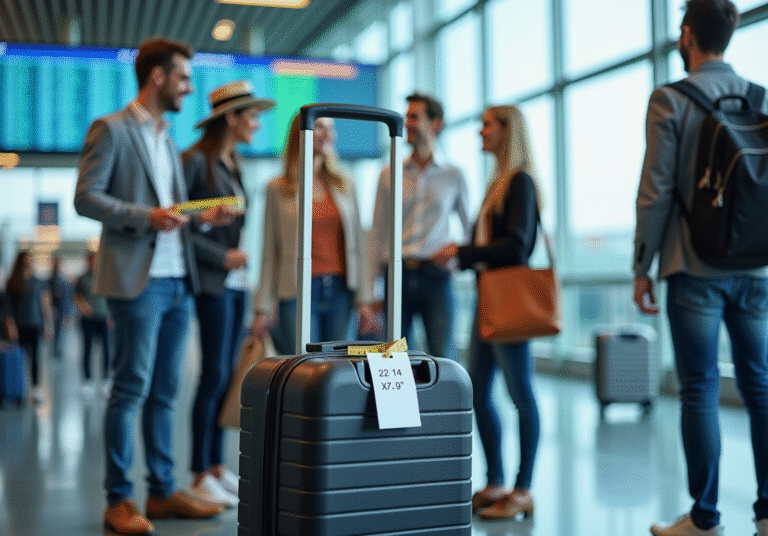Overview
This article is your go-to guide for understanding the average carry-on size for travelers—typically 22 x 14 x 9 inches. However, it’s essential to remember that these dimensions can vary by airline, so checking specific airline regulations is a must! By grasping these measurements and the differences between carry-ons and personal items, you can pack more efficiently and dodge those pesky extra fees.
After all, many airlines impose penalties for exceeding size limits, and nobody wants that surprise when they’re ready to jet off on an adventure!
Key Highlights:
- The average carry-on size is typically 22 x 14 x 9 inches, but this can vary by airline.
- Delta Air Lines has no weight restriction for carry-ons, while Allegiant Airlines imposes specific size limits and fees.
- Personal items are usually smaller (around 18 x 14 x 8 inches) and must fit under the seat in front.
- Different airlines have unique rules; for instance, Breeze Airlines allows personal items no larger than 17 x 13 x 8 inches.
- Packing cubes and rolling clothes can maximize space in your carry-on, potentially saving up to 20% more room.
- Exceeding carry-on size limits can result in fees ranging from $25 to $100, with 21% of Americans reportedly going over their baggage allowance.
- Travelers should regularly check airline websites for updates on carry-on policies to avoid surprises.
- Common misconceptions include the belief that all airlines have the same size restrictions and that personal items do not count towards baggage limits.
Introduction
Navigating the world of carry-on luggage can feel a bit overwhelming, right? With so many airline regulations and size restrictions, it’s easy to get lost in the details. But don’t worry! Understanding the average dimensions of carry-on bags—typically 22 x 14 x 9 inches—can set you on the path to a hassle-free travel experience.
However, it’s important to remember that variations exist! Different airlines have their own unique requirements, which can lead to some confusion and even unexpected fees. That’s why selecting the right luggage is crucial. In this guide, we’ll dive into the intricacies of carry-on sizes, helping you dodge common pitfalls and enhance your journey.
Whether you’re figuring out airline-specific policies or mastering the art of efficient packing, being informed is your secret weapon for a smoother, more enjoyable travel experience! So, let’s embark on this adventure together and make your next trip as seamless as possible!
The Design Tourist: Your Guide to Average Carry-On Sizes
The Design Tourist is your go-to guide for navigating the ins and outs of hand luggage sizes! Understanding the average carry on size permitted by airlines is key to ensuring a smooth travel experience. Generally, the average carry on size measures 22 x 14 x 9 inches, which totals 45 linear inches. However, keep in mind that airlines can vary, so it’s important to stay updated on their specific rules.
For instance, Delta Air Lines adheres to the standard measurements but doesn’t impose a weight restriction on hand baggage, allowing you one personal item that must fit under the seat in front of you. On the flip side, Allegiant Airlines lays out its own size restrictions for carry-ons and personal items, along with associated fees, which can really help you plan your packing effectively.
Experts emphasize the importance of practicality, especially when preparing for family trips. Travel advisors often recommend versatile luggage, like the Briggs & Riley International 21″ Carry-On Expandable Spinner, which fits perfectly with Hawaiian Airlines’ guidelines. By getting familiar with these dimensions and regulations, you can refine your packing strategies and set yourself up for a more enjoyable journey!
Airline-Specific Carry-On Size Limits: What You Must Know
Airlines have different size restrictions for personal items, which can sometimes leave travelers scratching their heads! In the U.S., most carriers follow the average carry on size of 22 x 14 x 9 inches for luggage. But here’s the catch: global carriers often have their own rules about the average carry on size. For example, Ryanair and EasyJet are known for their stricter dimensions, usually requiring bags to be smaller than that standard U.S. size. Breeze Airlines allows one personal item no larger than 17 x 13 x 8 inches, so it’s super important to check your carrier’s specific requirements before you start packing!
And let’s not forget Delta Air Lines, which has a 15-pound weight limit for carry-ons when flying to Singapore. As Lauren Dana Ellman wisely points out, “What you include in your personal bag is also subject to regulations.” To avoid any surprises at the airport, always take a moment to check the airline’s website for the latest baggage policies.
Oh, and here’s a little gem: Vueling doesn’t charge for hand luggage on certain fare categories, which can be a real win for travelers! To make your travel experience smoother, consider using resources like Kudos to manage your luggage efficiently and maximize rewards while booking your travel essentials. Happy travels!
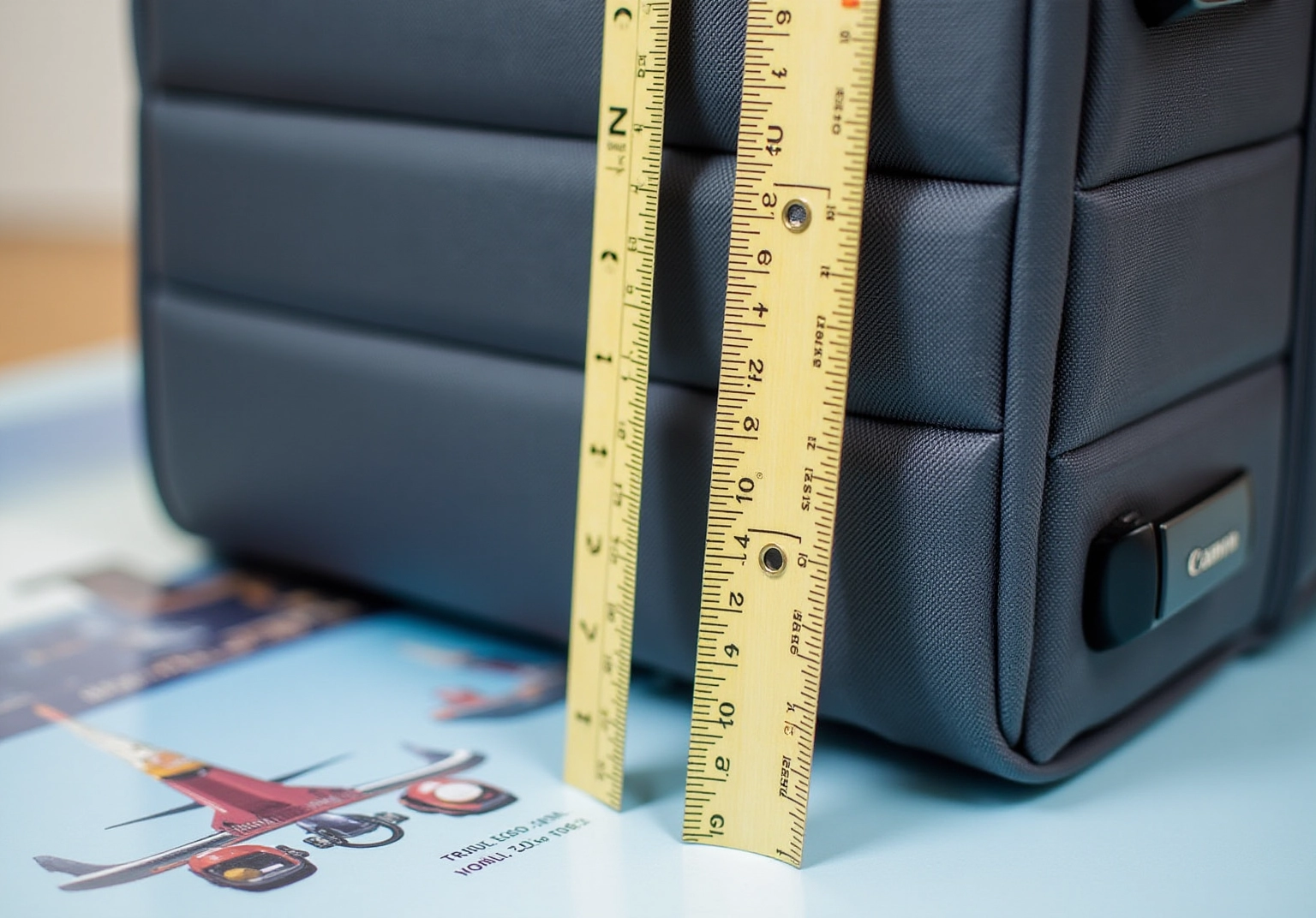
Carry-On vs. Personal Item: Understanding the Differences
When it comes to packing for your adventures, understanding the difference between a carry-on bag and a personal item is key! A carry-on bag is designed to be larger, fitting snugly into the overhead compartment, while a personal item is smaller, meant to slide right under the seat in front of you. Typically, personal items measure around 18 x 14 x 8 inches. Grasping this distinction can really enhance your packing strategies.
By making the most of both types of luggage, you can keep your essential items close at hand without racking up extra fees. For instance, did you know that Frontier Airlines has strict limits on the average carry on size for bags? They must not exceed the average carry on size, which is:
- 10 inches deep
- 16 inches wide
- 24 inches high
Additionally, bags should weigh less than 35 pounds. Knowing these details empowers you to pack smartly, steering clear of baggage hassles and making your overall travel experience a breeze!
As Peter Lucas, owner of Relocate to Andorra, puts it, “This step alone can help you save money and avoid any baggage hassles on your trips, ensuring a seamless experience.” Plus, if you join an airline’s frequent-flier program, you might snag some valuable baggage perks that can further enhance your travel experience. So, are you ready to pack like a pro?
Standard Dimensions for Carry-On Luggage: Key Measurements
The average carry on size for carry-on bags is widely recognized as 22 x 14 x 9 inches, including the wheels and handles. It’s super important to measure your baggage accurately to avoid any hiccups during check-in or boarding! While some airlines might allow slightly larger sizes, sticking to these standard dimensions is a smart move for a smoother travel experience.
Fast forward to 2025, and the average carry-on size dimensions globally are 21.5 x 15.5 x 9 inches, with a weight limit of 22 pounds. This shift shows that travelers are leaning towards more compact and manageable bags. To make sure you’re all set, grab a measuring tape or a handy tool specifically for measuring bags before you head out on your journey!
You might also find travel blogs to be a treasure trove of tips on how to measure luggage effectively, helping you dodge any surprises at the airport. For instance, packing cubes can be a game-changer! They allow for better organization within your travel bags, making it a breeze to find items and repack efficiently.
As Lauren Dana Ellman wisely points out, “What you include in your hand luggage is also subject to regulations,” which really emphasizes how crucial it is to understand these guidelines. By getting familiar with the average carry on size and these dimensions, you can refine your packing strategies and enjoy a more streamlined travel experience. And don’t forget to check specific flight regulations regarding hand luggage dimensions before you embark on your adventure to avoid any last-minute issues!
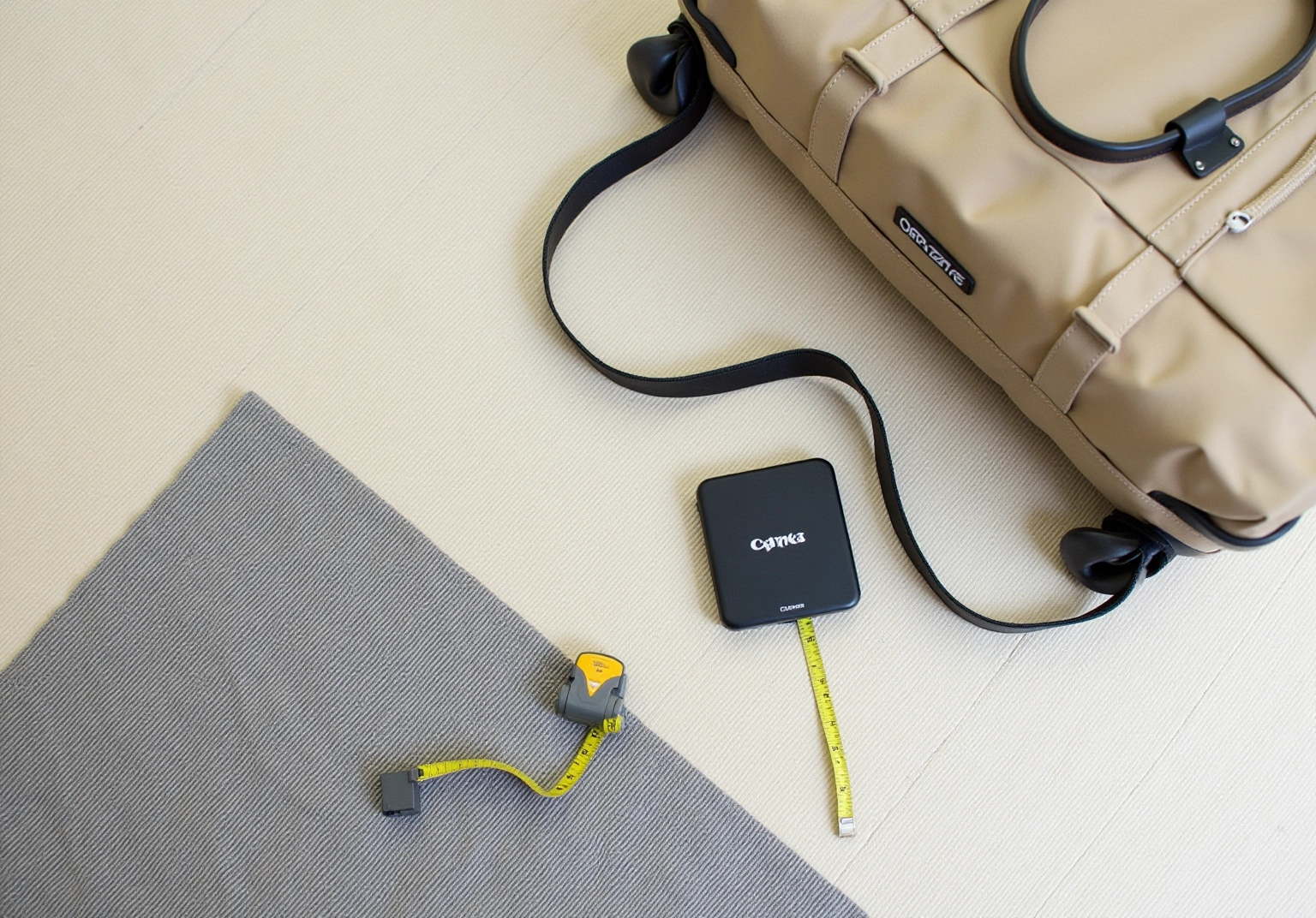
Weight Restrictions for Carry-On Bags: What to Expect
While many airlines don’t impose strict weight limits on carry-on luggage, it’s good to know that most major carriers allow economy passengers one carry-on that adheres to the average carry-on size and one personal item. Some airlines even suggest that the maximum weight for bags should correspond to the average carry-on size of around 15 to 22 pounds. This variation really emphasizes the need to check each airline’s specific policies related to average carry-on size before you travel. Exceeding the recommended limits regarding average carry-on size could lead to extra fees or the hassle of checking your bag.
If you’re flying basic economy, keep in mind that you’re typically allowed only one personal item, which means you might not have access to the overhead bins. This can definitely complicate your packing strategy! A case study on weight limits for hand luggage shows that many international airlines enforce stricter weight regulations, making it essential for you to be aware of the average carry-on size guidelines.
Packing light not only helps you stay within weight limits but also makes your journey through the airport much smoother. As Karen LeBlanc points out, “Testimonials from readers highlight the blog’s ability to transform ordinary trips into extraordinary journeys through its insightful content and unique perspectives on travel.” So, as you gear up for your adventures, being informed about these guidelines can truly enhance your travel experience and ease any stress.
A practical tip? Weigh your luggage at home before heading to the airport to avoid any surprises!
Average Carry-On Size: Why It Matters for Travelers
The average carry on size of 21.5 x 15.5 x 9 inches is designed to fit snugly in most flight overhead bins. It’s essential for you to grasp this specification! Following these dimensions not only ensures you’re in line with flight regulations but also maximizes your packing space, making your travel experience so much smoother. By choosing baggage that meets these criteria, you can sidestep delays and avoid those pesky fees for oversized bags. Did you know that travelers who stick to the standard cabin size often enjoy a more seamless boarding process and greater satisfaction during their trips?
To make the most of your packing space, Elina Geller, a former NerdWallet travel writer, suggests using a handheld scale. This little tool helps you avoid exceeding weight limits, which can lead to extra charges and frustration.
Including travel backpacks as a primary personal item option has become quite the trend among frequent flyers! These versatile bags offer flexibility and ease of movement, making the boarding process a breeze and reducing the need to check bags. Studies show that travelers who opt for backpacks face less hassle and better compliance with airline regulations, especially when considering those typical cabin bag dimensions.
It’s also worth noting that airlines like Vueling don’t charge for cabin bags if you’re flying with TimeFlex or Premium Fare tickets. This can definitely influence your choices when it comes to selecting your bag. In the end, understanding and adhering to the average carry on size is key for a smooth travel experience. It allows you to focus on enjoying your trip rather than stressing over baggage limitations!
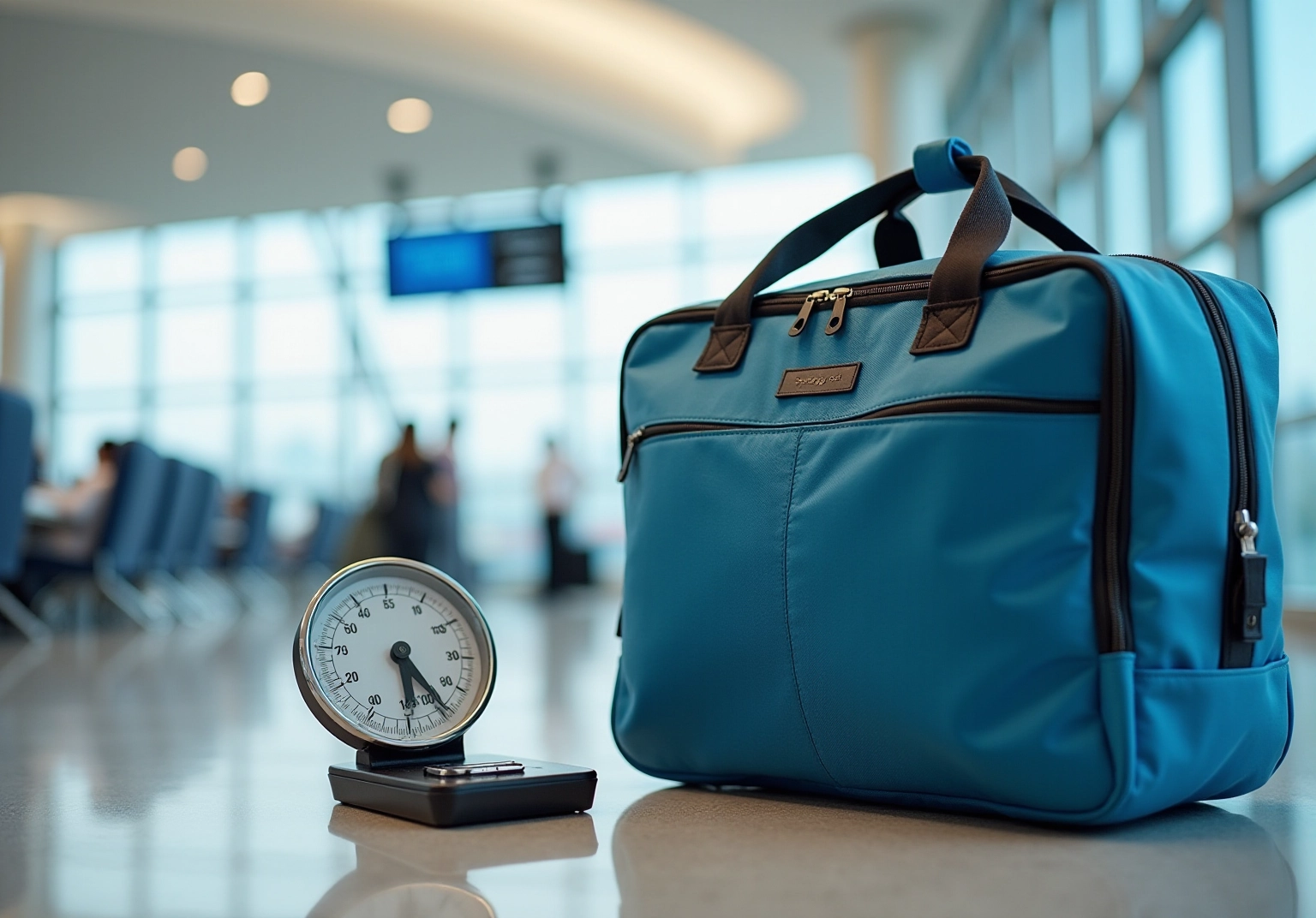
Consequences of Exceeding Carry-On Size Limits: Avoiding Fees
Exceeding the average carry on size limits can lead to some hefty consequences, such as paying those annoying fees or even having to check your bag right at the gate! Airlines usually charge between $25 and $100 for oversized carry-ons, depending on their specific rules. Did you know that a study found 21% of Americans have gone over their baggage allowance? Often, they face the tough choice between shelling out an average fee of $45 for excess baggage or leaving items behind. Commonly tossed items include:
- Lightweight clothes
- Books
- Personal care products
Many folks find it’s actually cheaper to buy things again later than to pay for extra baggage.
To dodge these unexpected costs, it’s super important to know your airline’s hand luggage rules, especially the average carry on size, and check your bags before heading to the airport. As one expert wisely pointed out, “So rather than looking for ways to outsmart the system, it’s really better to keep to the limits.” By sticking to the size requirements, you can ensure a smoother journey and avoid those surprise expenses. Happy travels!
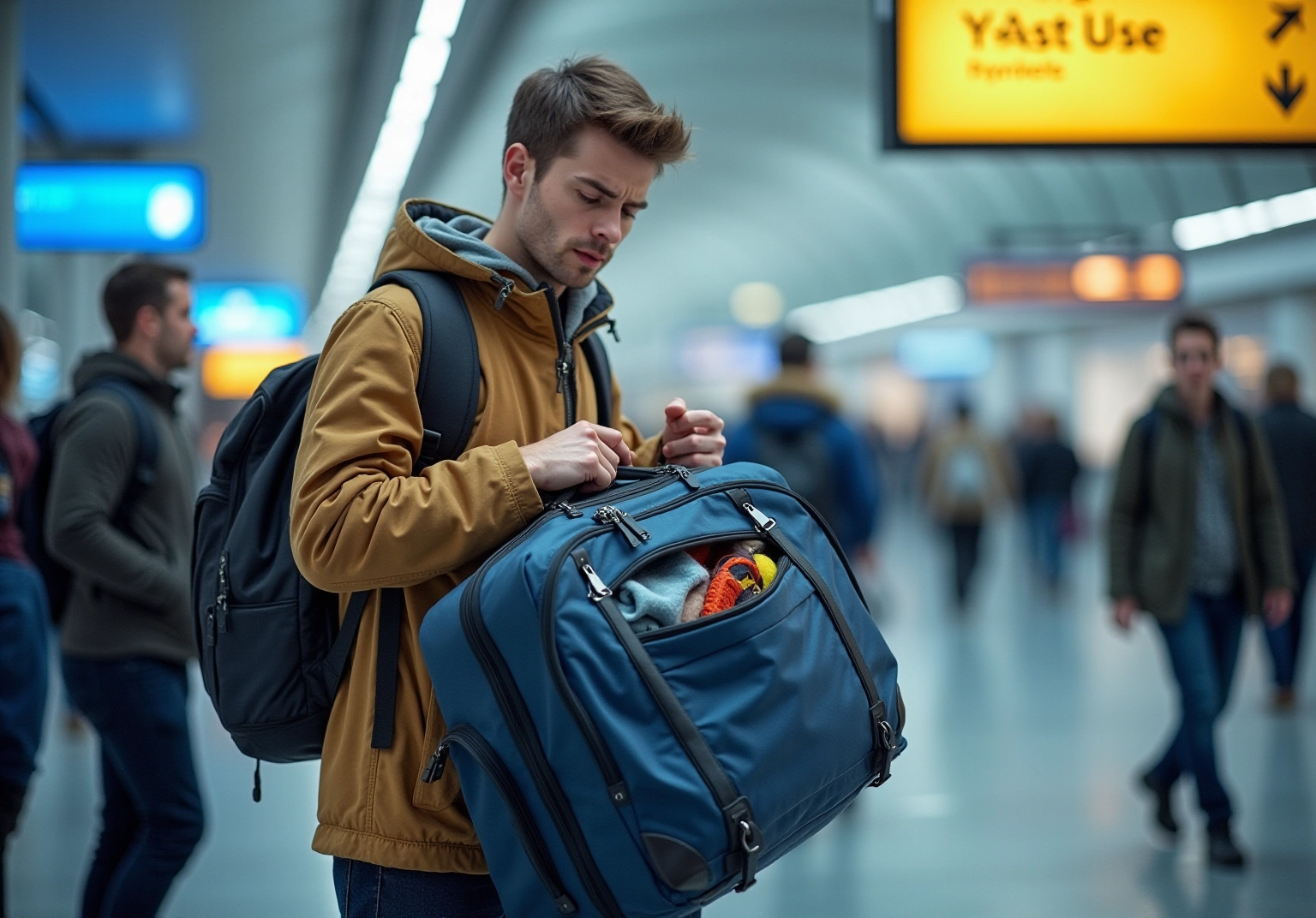
Stay Updated: Changes in Carry-On Policies You Should Know
Hey there, fellow traveler! Did you know that carry-on policies can change? Carriers are always adjusting to new regulations and customer needs, so it’s super important for you to stay in the loop about your airline’s rules—especially when it comes to size and weight restrictions.
I always recommend checking your airline’s website regularly or even subscribing to travel news. This way, you’ll be well-prepared for any changes that might pop up and impact your travel plans.
Happy travels!
Maximize Space in Your Carry-On: Packing Tips
To maximize space in your luggage, consider using packing cubes! They help you organize items efficiently. Rolling your clothes instead of folding them can save space and reduce wrinkles—studies show this method can save you up to 20% more room! Plus, don’t forget to utilize every inch of your bag by stuffing smaller items, like socks, into your shoes.
If you’re heading to a cold weather location, take a tip from travel expert Teferra: wear your bulkier items, like a coat and boots, to save even more space. Prioritizing versatile clothing that can be mixed and matched will also help you pack lighter and smarter.
Incorporating these strategies can significantly enhance your travel experience, ensuring you have everything you need without the hassle of overpacking. And here’s a bonus: packing strategically can minimize delays at airport security, making for a smoother travel experience. Happy travels!
Common Misconceptions About Carry-On Sizes: What to Clarify
Many travelers mistakenly believe that all airlines have the same size restrictions for hand luggage, but that’s a common misunderstanding! While the average carry on size is generally 22 x 14 x 9 inches, there are variations among carriers. It’s crucial to check the specific requirements before you travel. Plus, there’s a widespread belief that personal items, like purses or backpacks, don’t count towards the baggage limit. This is not the case; most airlines do include personal items in their overall baggage policies. Understanding these nuances is key for a smooth travel experience and can help you avoid unexpected fees or complications at the airport.
Statistics show that a significant number of travelers are unaware of the specific luggage regulations for their chosen airlines, leading to confusion and frustration. For instance, the average carry on size allowed by Southwest Airlines is 24 x 16 x 10 inches, and there’s no weight restriction, yet many travelers don’t know these details. In 2024, the revenue from the suitcases and briefcases market revealed considerable geographical diversity, highlighting varied consumer demand and the importance of grasping carry-on regulations.
It’s essential to debunk these myths if you want to navigate the complexities of air travel efficiently. As tech blogger Tajammul Pangarkar wisely points out, “Understanding the nuances of travel regulations can significantly enhance the travel experience.” Travel blogs often break down these rules, offering valuable insights that can help you pack more efficiently and travel lighter. By addressing these common misconceptions, you can ensure a smoother journey and make the most of your carry-on allowances. And don’t forget, North American carriers like Amtrak provide generous weight limits for checked bags, giving you alternative options to consider!
Conclusion
Understanding the average dimensions and regulations surrounding carry-on luggage is essential for any traveler looking to enjoy a hassle-free journey! The standard size of 22 x 14 x 9 inches is widely accepted, but variations among airlines remind us to familiarize ourselves with specific policies. For instance, Delta Air Lines has no weight limit, while Allegiant Airlines imposes detailed size restrictions. Knowing these differences can help you avoid unexpected fees and complications at the airport.
Moreover, distinguishing between carry-on bags and personal items is crucial. A carry-on is designed for the overhead compartment, while personal items fit snugly under the seat. This knowledge allows you to optimize your packing and keep essential items easily accessible. Using tools like packing cubes and rolling clothes can further maximize space, leading to a more efficient travel experience.
Ultimately, staying informed about airline regulations, understanding size limits, and employing smart packing strategies empower you to navigate the complexities of air travel with confidence. By following these guidelines, you can focus on enjoying your journey rather than worrying about luggage restrictions, ensuring a smoother and more enjoyable travel experience!
Frequently Asked Questions
What is the average carry-on size permitted by airlines?
The average carry-on size permitted by airlines is generally 22 x 14 x 9 inches, totaling 45 linear inches.
Do all airlines have the same carry-on size restrictions?
No, airlines can vary in their carry-on size restrictions. It is important to check each airline’s specific rules before traveling.
What are the carry-on policies for Delta Air Lines?
Delta Air Lines adheres to the standard carry-on measurements but does not impose a weight restriction on hand baggage. Passengers are allowed one personal item that must fit under the seat in front of them.
What are the carry-on policies for Allegiant Airlines?
Allegiant Airlines has its own size restrictions for carry-ons and personal items, along with associated fees.
What should travelers consider when packing for family trips?
Travelers are encouraged to use versatile luggage, such as the Briggs & Riley International 21″ Carry-On Expandable Spinner, which fits well with Hawaiian Airlines’ guidelines.
What is the difference between a carry-on bag and a personal item?
A carry-on bag is larger and designed to fit in the overhead compartment, while a personal item is smaller and meant to fit under the seat in front of you. Personal items typically measure around 18 x 14 x 8 inches.
What are the carry-on size limits for Frontier Airlines?
Frontier Airlines has strict limits for carry-on bags, which must not exceed 10 inches deep, 16 inches wide, and 24 inches high, with a weight limit of less than 35 pounds.
How can travelers avoid baggage hassles?
By understanding the size restrictions and making the most of both carry-on bags and personal items, travelers can keep essential items close without incurring extra fees.
Are there any airlines that do not charge for hand luggage?
Yes, Vueling does not charge for hand luggage on certain fare categories.
Why is it important to check the airline’s website before traveling?
It is important to check the airline’s website for the latest baggage policies to avoid surprises at the airport.









